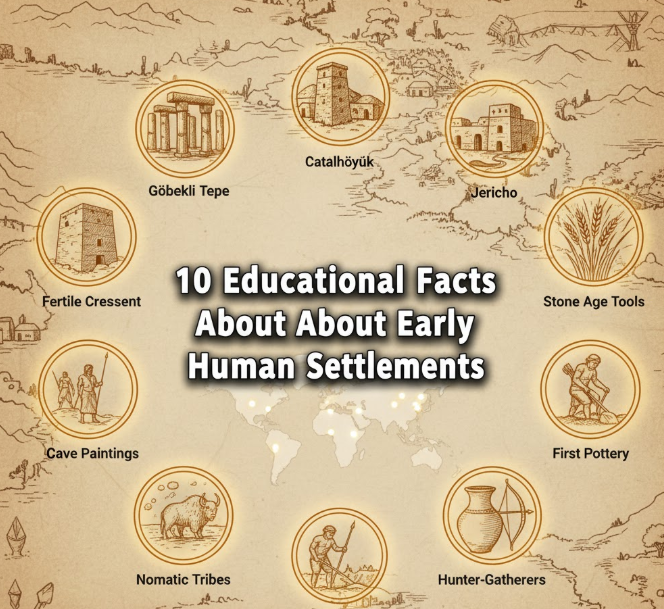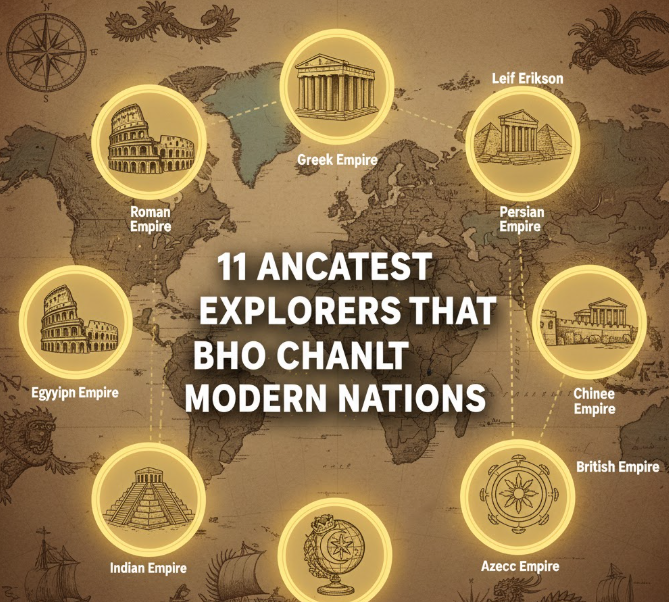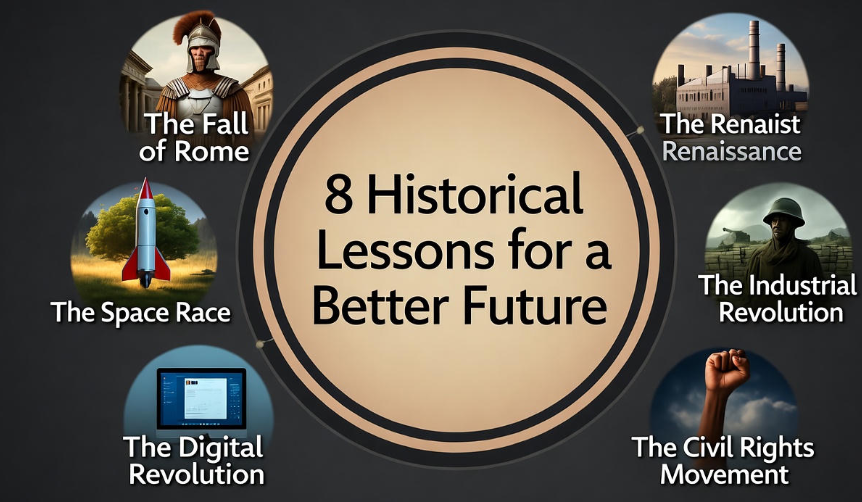Think of a world with no towns, no houses, not even small villages. For the vast majority of human history, our ancestors roamed — they followed herds of animals, seeking the best hunting grounds and searching for wild plants to eat. Then, something incredible happened. People decided to settle down in one place and build houses — the first settlements were made. This development would change human life forever, and it set us on the trajectory to construct the world we inhabit today.
“The fact that our human ancestors were so daring, going to these places where the resources are often very difficult and unpredictable to exploit because of these kinds of bitter swings, is really quite a marvel,” Professor Cooper said. People had to learn to solve new problems, invent new tools and work together in ways they had never done before when they stopped moving around and began living in one place with a group of people permanently. These early settlements weren’t just places to sleep at night; they were the birthplaces of agriculture, trade, religion and organized society.
In this post, we’ll go through ten awesome facts about these early settlements to give you an idea of what it was like for our distant ancestors. You’ll start with the oldest known city, and the reasons that people began to give up their nomadic way of life. You will find the foundations of human civilization.
Why Did Humans Stop Roaming and Settle Down?
For tens of thousands of years, humans hunted and gathered food, roaming from place to place in search of things to eat. So what made them suddenly decide to hang around? The response is not as obvious as you might assume.
Its principal cause was the invention of agriculture. Somewhere between 10,000 and 12,000 years ago, in various parts of the world, people began working out how to put seeds into the ground in rows and thus grow their own food. This occurred in something called the Neolithic Revolution. Instead of spending all day hunting animals and foraging for berries, people could now grow wheat, barley and other crops directly where they lived.
When you can farm food in one place, it makes sense to stay there. Building permanent homes was worth the effort, people knew they were going to be staying for years and not just a few weeks. They also began to domesticate animals like goats, sheep and cows, which provided them with a steady source of meat, milk and leather without having to hunt.
There was another pressing factor, too: climate change — but not the sort we talk about today. The Earth was emerging from the last Ice Age about 12,000 years ago. The climate was warmer and more stable, so it became easier to grow crops. Rivers and lakes were more reliable sources of water, which then drew both livestock as well as people.
Settlement life was also protective. And when there were a number of people living with each other, they could protect themselves from beasts and rival humans better. They could pool resources and help build homes as well as care for the sick or injured among their community.
Jericho, the Oldest City that Never Was
Whenever historians speak of the oldest settlement on earth, Jericho is always at the forefront. Just to the north of the Jordan River in present-day West Bank, Jericho has been inhabited for more than 11,000 years. That pushes into the ranks of one of the longest continuously inhabited places on Earth.
Jericho began as a tiny encampment for hunter-gatherers arriving to drink from a natural spring. Gradually more and more people arrived and they began to construct mud-brick round huts. By about 9,000 B.C.E., Jericho had become a true town of some 2,000 to 3,000 people.
But what makes Jericho even more impressive, is the wall that surrounds it. The inhabitants of Jericho are known to have constructed a high, thick stone wall around their city, with a great tower. This tower stands almost 28ft in height and would have involved considerable effort to construct without modern tools. Archaeologists think the wall was constructed to shield against floods, or maybe even other people.
The spring that proved a magnet to the first settlers is still running, proving once again how important location was for the early settlements. Fresh water was absolutely essential, crops needed water, animals needed water and people needed it to drink or cook with.
Jericho is evidence that human settlements did not spring up overnight. They evolved over hundreds of years as people garnered new skills and discovered how to live together in bigger groups.
Çatalhöyük: The City of the Weird and Alley-less
In southern Turkey, archaeologists uncovered one of the strangest old homes ever found: Çatalhöyük. This community existed between 7500 and 5700 BCE, and at its peak was inhabited by somewhere around 3,000 to 8,000 people.
What makes Çatalhöyük so weird? The city had no streets. Instead, the homes were constructed butt up against each other, “like a honeycomb.” You entered your own home by climbing onto the roof and sliding through a hole in the ceiling. The people walked over the roofs, passing from house to house in the city, using ladders to go in and out of the houses.
This is an odd design, but it actually made sense from the perspective of defense. Enemies or wild animals were less likely to be able to attack when there were no streets or doors at ground level. The settlement was like a vast single building with no obvious, easy entrance from the outside.
In the homes, families kept it pretty neat. They had designated spots for cooking, sleeping and working. They even expanded their homes with the ground they dug for burials, demonstrating a connection to ancestors and living space.
The inhabitants were talented artists and craftsmen. But they made splendid wall paintings featuring hunting scenes, wild animals and geometric designs. They produced tools from obsidian (a volcanic glass), pottery and even mini-sculptures. Some archaeologists believe that Çatalhöyük was among the first places where art became significant outside of religious ceremony in people’s daily lives.
How Agriculture Began It All
Before settlements were established, humans hunted animals and collected wild plants for their food. It worked well enough, but had its limits. You could eat only what nature handed you, and if the animals moved or the plants failed to fruit, you might go hungry.
Agriculture changed all of this. They taught people how to plant seeds, water them and harvest crops months later. The first crops were basic grains like wheat and barley in the Middle East, rice in Asia and corn in the Americas. This realization occurred independently in various corners of the world, indicating that it was a natural progression of human development.
Crops were nothing more than edible plants people could grow themselves, at a time when farming meant that humans could produce more food than they needed to keep from starving. This surplus food was revolutionary. It might also have meant that some individuals didn’t spend all day procuring meals — they could be craftspeople, builders or religious leaders instead. The division of labor structured society at a higher level.
Yet agriculture also posed new problems. Farming is sweaty, backbreaking toil which you can’t do with people moving around over the growing season. You had to figure out what seasons were, when you want to plant and when you gather, how and what do I store for the winter. They also had to face new problems including crop diseases, droughts and pests.
Here is a basic juxtaposition of hunter-gatherer life and settled farming life:
| Hunter-Gatherer Life | Settled Farming Life |
|---|---|
| Move from place to place with the seasons | Stay in one location through all of the seasons |
| Eat a variety of wild foods | Eat mainly farmed crops and domesticated animals |
| Small groups (20-50 people) | Large communities (hundreds or thousands) |
| Few possessions—must carry everything | Tools, furniture, etc. can start to accumulate |
| More egalitarian | Social classes starting to develop |
| Less disease (no crowded living) | More diseases spread in close quarters |
Göbekli Tepe: Religion Before Settlements
For centuries, historians thought that humans built settlements and then developed organized religion. In Turkey there’s a site called Göbekli Tepe and it completely upended that theory.
Göbekli Tepe is a gigantic temple complex that was erected around 9500 BCE — that’s roughly 11,500 years ago. The shocking part? It was constructed by hunter-gatherers who had not yet settled down. They did not live at Göbekli Tepe; they came to it from time to time for religious events.
Huge stone T-shaped pillars, some as heavy as 20 tons, dominate the site. These pillars are decorated with carvings of animals such as foxes, snakes, wild boars and birds. Constructing that complex would have involved hundreds of people working together, which suggests that hunter-gatherers could mobilize on a large scale even if they did not yet have permanent homes.
Now some archaeologists believe that religious gatherings like those staged at Göbekli Tepe may have inspired people to start living together in larger groups. When people congregated all the time at a holy site, it was only logical to live nearby. They had to grow some food — for everyone who came for the ceremonies, because people would come from hundreds of miles around. And so agriculture began, and then they settled down.
This find tells us that our ancestors were much more sophisticated than we sometimes like to give them credit for. They didn’t just start farming because it seemed like the thing to do — they had intricate spiritual beliefs and social structures that dictated how and where they lived.

The First Villages Gave Rise to Modern Cities
It would take millennia for little farming towns to evolve into anything resembling a city, but the process began with those initial settlements. As these settlements became bigger and more organized, they acquired features we associate with cities today.
The first was population growth. When farming yielded extra food, communities could take care of more people. Villages of a few hundred people expanded into towns of thousands.
Next came specialization. Not as many people had to farm, and so they developed specialties. Some turned to pot-making, others to weaving and still some were traders. This system brought into being an economy in which people exchanged goods and services rather than each doing what needed to be done from end to end.
Then came social hierarchy. In small groups of hunters, everyone was pretty much in the same boat. But in populous settlements, leaders crystallized. Some got rich by trading, some established power through religion and others used family ties to assume command. This inequality was unfamiliar to human society.
Systems for management of resources were also developed at an early stage. Officials had to determine how to share water, where people could construct houses and how best to protect the settlement. These systems of management were the start of government.
At that time, some of their settlements had evolved into genuine cities with several thousand inhabitants, monumental buildings, script and centralized rule. Uruk in Mesopotamia and Memphis in Egypt were direct descendants of those original small farming villages.
The Technology Behind Early Settlements
Settlement building is more than the decision to hang your hat in one place. In order to make permanent living work, early humans had to invent new technologies and refine old ones.
Construction Technology: The earliest permanent buildings were simple stuff—sometimes nothing more than dry stone circles with wooden poles to hold up thatched roofs. But the mud-brick business spread quickly as people discovered how to mix muddy water with straw and let it dry in the sun. These blocks of mud were great for homes because they were strong, insulated houses from heat and cold, and could be made anywhere there was the right soil.
Storage Technology: If you’re always on the move, you can’t store a lot of food, either. But sedentary people had to have a way of storing grain and other foods for months. They developed large clay pots, baskets made of twisted fibers that were lined with clay and eventually constructed special rooms to store their food. This might sound unremarkable, but it was a prerequisite for survival: one poor harvest and without stored food you would starve.
Farming Tools: Farming also demanded new types of tools. In response, individuals created sickles to shear the grain (originally a wood instrument with jagged flint rocks embedded; later one made of metal). They made grinding stones and turned grain into flour. They cultivated the first plows, which were simply pointed sticks dragged through soil to create furrows for planting.
Water Control: Villages required dependable sources of water. Early settlers dug canals to funnel water from springs or rivers onto their fields. They sunk wells to get to water that was underground. Some settlements even constructed the most rudimentary of dams and reservoirs to hold water for dry times.
All of these were experimental, collaborative technologies. People needed to exchange information, teach one another new skills and collaborate to create infrastructure that served everyone.
Timeline of Major Early Settlements
| Time Period | Settlement/Region | Significance |
|---|---|---|
| 11,000 BCE | Jericho (Jordan Valley) | One of the oldest continuously-inhabited cities; constructed defensive walls |
| 9500 BCE | Göbekli Tepe (Turkey) | Large religious site built by hunter-gatherers |
| 7500-5700 BCE | Çatalhöyük (Turkey) | Large settlement that incorporated a system of entering through roofs |
| 7000 BCE | Mehrgarh (Pakistan) | Early farming village in South Asia |
| 6500 BCE | Ain Ghazal (Jordan) | One of the largest Neolithic settlements |
| 5500 BCE | Cucuteni-Trypillia (Ukraine) | Advanced settlement with large buildings |
| 5400 BCE | Eridu (Mesopotamia) | One of the earliest cities in Mesopotamia |
Life on the Early Settlements Was Hard
Settling led to many gains, but also brought new problems that hunter-gatherers never had.
Settlements, after all, were where disease could spread most effectively. When hundreds or thousands of people live near each other and share water supplies, diseases can spread quickly. Archaeological evidence suggests that those who lived in early settlements experienced more infectious diseases than did their hunter-gatherer ancestors.
Violence increased in some settlements. When people are holding property, are actually storing food somewhere, there is something to fight over. Warfare is also known from the archaeological record, with remains of fortifications and of people having died violent deaths – possibly at times as evidence of sacrifice. Some settlements were even deserted after an attack.
Nutrition sometimes got worse. Hunter-gatherers consumed a wide variety of different plants and animals. Survival farmers tended to depend on a relatively small number of crops, which meant less diversity in their diet. Analyses of ancient skeletons have found that, in some cases at least, early farmers were shorter than hunter-gatherers and had more dental problems — evidence that their diet wasn’t always perfect.
Social inequality emerged. In groups of hunter-gatherers, everyone was more or less equal. But in the settlements, some people emerged as wealthy landowners and others as servants or slaves. This inequality fostered social tensions that didn’t plague smaller, more egalitarian groups.
For many, work became more difficult. Farming demands long days of backbreaking toil — plowing fields, pulling weeds, harvesting crops. Some anthropologists say that hunter-gatherers actually worked fewer hours a day than early farmers did.
Despite this struggle, settlements were built and people lived. Most people found the benefits — security, community, dependable food supply — outweighed the drawbacks.
What Happened to Hunter-Gatherers?
As settlements began popping up globally, however, most of these groups ultimately transitioned to farming and settled. But this transformation did not take place overnight, nor is it playing out consistently from coast to coast.
In certain sites, hunter-gatherers and farmers coexisted for thousands of years. The hunter-gatherers might exchange wild game and fur for grain or other farmed goods with the farmers. Hunter-gatherers would occasionally settle temporarily during the harvest season to aid with farm work, but they would then pack up and move on.
But over time, the settlements expanded and seized all the good land. Wild animals were killed off or hunted into local extinction. Hunter-gatherers had fewer open spaces in which they could move about. Most groups gradually gave up a hunter-gatherer lifestyle, not because they wanted to, but because they had little choice.
But there are a few people whose lives have continued in this way to the present day, scattered throughout the world’s most remote regions. These groups demonstrate to us that the hunting-and-gathering way of life is viable and even satisfying. But for most of our species, the move to a settled way of life was one we could never go back on.
But genetic studies reveal that modern people outside Africa are primarily descended from the farmers who established those settlements, not from the hunter-gatherers. If one mode of living is growing much more rapidly, it eventually will become the dominant way of life, meaning settled populations expanded faster than nomadic or semi-nomadic groups.
The Legacy of Early Settlements
Indeed every city, town and village in the world today is that way because people several thousand years ago decided to stop wandering and instead settled down to build permanent homes. These inaugural little settlements were the start of everything we mean by civilization.
The problems those early settlers confronted — how to cooperate, how to share resources, how to resolve disputes — are problems we continue to confront today. And the solutions they devised — laws, property rights, leaders, trade — are the blueprint for our contemporary societies.
Even our routines link to those original settlements. We wake up in buildings we’ll never leave, eat food produced by farmers, work specialized jobs and live with thousands of strangers. All it took was for someone to decide to plant seeds in the earth and stick around long enough to harvest them.
The very essence of the tale of early settlements is a story of human ingenuity and resilience. Their parents didn’t leave them a guide on building a city, or how to grow your own crops. They tried, failed and learned from each other, slowly figuring out what they were doing. That spirit of creativity and problem-solving continues to animate human achievement today.
Learn more about the Neolithic Revolution and early human settlements from World History Encyclopedia.
In Conclusion: The Foundation of Human Civilization
The early settlements of man is one of the greatest transitions in human history. When humans stopped roaming and began to settle down in permanent homes, they initiated a series of changes that eventually seeded the complex contemporary world we inhabit.
These first settlements weren’t perfect. They also carried disease, inequality and occasional violence. But they also owned stability, community and the opportunity for individuals to learn new skills or acquire information on how to improve their lives. They freed humans from spending every waking hour just surviving so they could get down to the business of making art, religion, technology and culture.
From the ancient walls of Jericho to Çatalhöyük’s entrances on the roof, each early settlement has something unique to tell us about human creativity and adaptation. These were more than homes in which to live; they were experiments with how people could order their lives, work and cooperate and create something lasting.
Today, billions of people live in cities with roots stretching back to those early small farming villages. The next time you go for a walk down the street, shop in a market or live in an inhabited building, remember that you’re contributing to a tradition that began over 10,000 years ago when our ancestors chose to settle and established the first human habitations.

Frequently Asked Questions
What was the earliest human settlement?
From the Jordan Valley to Jericho. There are several cities in Israel and Palestine that vie for the title of oldest continually inhabited settlement, with one of them being Jericho in the Jordan Valley, established about 11,000 years ago. But there must have been more temporary or small settlements that predate them, the evidence for which was obscured.
Why did early humans settle in particular places?
There were three main things early settlers sought: fresh water (from springs or rivers), good soil to grow crops and natural protection (such as a hill or body of water). Water access was the most significant factor.
Early settlements were typically inhabited by how many people?
Early settlements would, by today’s standards, be pretty small. The first few, maybe 50-100 people. Larger settlements, including Çatalhöyük, ended up accommodating 3,000 to 8,000 people—massive for the time.
Were there any type of governments in first settlements?
Early communities probably had leaders who were informal, rather than formal government. Decisions were likely made by elders, religious leaders or successful farmers. As settlements became bigger, more structured systems of leadership evolved.
What did early settlers eat?
Early settlers were primarily consumers of farmed foods, such as wheat and barley, lentils and peas. They also raised domesticated animals, such as goats, sheep and cattle for meat and milk. They would add to this with game, fish and gathered plants when the opportunity arose.
How were the houses of people in early settlements constructed?
The majority of these early houses were made from mud bricks formed of clay, straw, and water, then dried in the sun. They were supported by wooden poles and had roofs made of tied reeds or grass. Stone was employed where obtainable, notably for foundations.
Did the early settlements link up with each other?
Evidence exists, however, that early settlements did in fact trade with one another, sometimes over long distances. They traded obsidian (volcanic glass used for tools), shells, pottery and food goods. The exchange also led to new networks of sharing among diverse communities.
How quickly did settlements spread across the globe?
Agriculture and populations originated independently in various regions after a period spanning thousands of years. The Middle East was settled around 10,000 BCE, China was settled around 7,000 BCE and Mesoamerica around 5,000 BCE, while other regions developed settlements at different times. It was not a single spreading wave but many independent developments.




